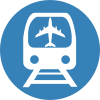Transportation in South Korea is provided by extensive networks of railways, highways, bus routes, ferry services and air routes that traverse the country. South Korea is the third country in the world to operate a maglev train, which is an automatically run people mover at Incheon International Airport.

Incheon, formerly Jemulpo or Chemulp'o (Korean: 제물포) until the period after 1910, officially the Incheon Metropolitan City (인천광역시), is a city located in northwestern South Korea, bordering Seoul and Gyeonggi Province to the east. Inhabited since the Neolithic, Incheon was home to just 4,700 people when it became an international port in 1883. As of February 2020, about 3 million people live in the city, making it South Korea's third-most-populous city after Seoul and Busan.

Incheon International Airport — or simply Incheon Airport — is the main international airport serving Seoul, the capital of South Korea. It is also one of the largest and busiest airports in the world.

The Seoul Metropolitan Subway is a metropolitan railway system consisting of 23 rapid transit, light metro, commuter rail and people mover lines located in northwest South Korea. The system serves most of the Seoul Metropolitan Area including the Incheon metropolis and satellite cities in Gyeonggi province. Some regional lines in the network stretch out beyond the Seoul Metropolitan Area to rural areas in northern Chungnam province and western Gangwon Province, that lie over 100 km (62 mi) away from the capital.
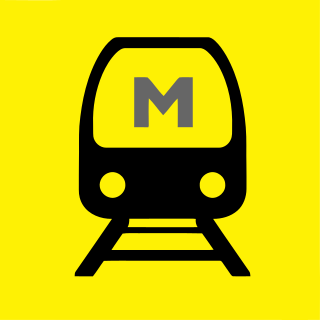
Rapid transit systems operate in six major South Korean cities, except for Sejong.
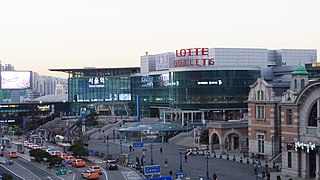
Seoul Station (Korean: 서울역) is a major railway station in Seoul, the capital of South Korea. The station is served by the Korail Intercity Lines and the commuter trains of the Seoul Metropolitan Subway.

Bucheon is a city in Gyeonggi Province, South Korea. Bucheon is located 25 kilometers (16 mi) away from Seoul, of which it is a satellite city. It is located between Incheon and Seoul.

Gwangju Airport is an airport in Gwangju, South Korea, and is managed by the Korea Airports Corporation. In 2018, 1,986,125 passengers used the airport. This airport is planned to close when Muan International Airport becomes more established. Because Gwangju Airport is sharing with military, taking photograph or video of apron, runway and military facility is strictly prohibited.

Seoul Subway Line 9, operated by Seoul Line9 Operation, is a subway line in Seoul, part of the Seoul Metropolitan Subway. The line runs east from Gaehwa station or Gimpo International Airport station along the south bank of the Han River towards VHS Medical Center in Gangdong. In 2019, Line 9 had an annual ridership of 225 million or about 616,000 people per day.
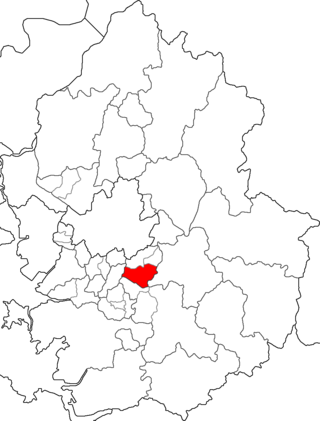
Bundang District is the largest and most populous district (gu) of Seongnam, a major city in the Seoul Capital Area, South Korea. Bundang District is one of South Korea's wealthiest and highest developed areas, being the nation's first and largest completely artificial city built in the early 1990s. Many high-rise luxury condos moved in the early 2000s, with a second planned city built in the late 2000s called Pangyo in the same district. Apartment prices are the second highest in Gyeonggi Province after Gwacheon and 7th highest nationwide, higher than many central Seoul districts such as Mapo District or Jongno District. Apartments around Pangyo station and the high-rise luxury condos around Jeongja station and Sunae station rival prices in the most expensive areas in the country. Unlike older cities such as Seoul, Bundang has no telephone poles overground, resulting in a clean cityscape with well-designed streets.

Gimpo International Airport Station is a subway, railway and light rail station on Seoul Subway Line 5, Line 9, AREX, the Gimpo Goldline and the Seohae Line. True to its name, it serves the nearby Gimpo Airport, the hub of domestic flights in the Seoul metropolitan area as well as a limited number of regional international flights to and from China, Japan, and Taiwan. Upon its opening in 1996, it became the first railway station in the Korean Peninsula to directly serve an airport.

AREX is a South Korean airport rail link and commuter rail line that links Incheon International Airport with Seoul Station via Gimpo International Airport.
Seoul, the capital and largest city in South Korea, accounts for only 0.6% of the country's total land area, yet it is home to around 19% of the population. The population density in Seoul demands a great deal of the city's transportation systems, which are regarded by many as among the best and most advanced in the world. Seoul is very well connected by its subway and bus systems, and the city is also very supportive of pedestrian foot travel. In 2006 it won the Sustainable Transport Award.

The Honam high-speed railway, also known as Honam HSR, is a high-speed rail between Osong and Mokpo in South Korea. The line is a part of Korail's Korea Train Express (KTX) system, accelerating Seoul–Mokpo and Seoul–Gwangju KTX high-speed services which currently use the existing conventional Honam Line. On April 1, 2015, the line was inaugurated by the South Korean President Park Geun-hye with the attendance of 1200 invited guests and members of the public at Gwangju Songjeong Station in Gwangju, the line's terminus. The line diverges from Osong station on the Gyeongbu high-speed railway, and stops at Gongju, Iksan, Jeongeup Stations. Journey times between Seoul and Gwangju has been cut from 2 h 40 min to just 90 min, making daily commuting possible. The Honam HSR is intended to bring business, and economic opportunities to the province of Jeollanam-do, which has seen slower development than other parts of South Korea. The line has been open to the public since April 2, 2015 for revenue service.

Choji Station (Korean: 초지역) is a commuter railway station on Seoul Subway Line 4, the Suin–Bundang Line and the Seohae Line in Ansan, South Korea. Trains on Line 4 utilize what is officially named the Ansan Line within the city of Ansan, as do those on the Suin-Bundang Line, which stop at the station on the same tracks using the same platforms.
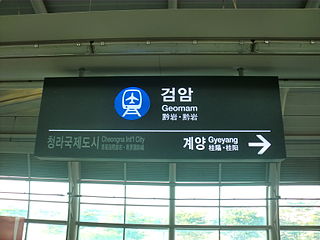
Geomam station is a railway station on AREX and Incheon Subway Line 2. Since June 2014, the KTX train operates from Incheon International Airport to Busan or Mokpo. It has stopped operating KTX since March 2018. In September 2018, Korail officially announced that they would stop operating KTX to Incheon International Airport due to lack of passenger use. This was the first KTX station after Incheon Airport. Before KTX started to run on AREX, all platforms were high-leveled with screen doors. The KTX started to run, they took away the platform screen doors only at the both end of the side horizontally and turned into low-leveled platform without screen doors.
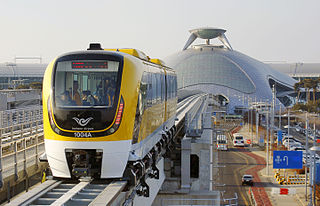
The Incheon Airport Maglev was a maglev line in South Korea that opened on 3 February 2016 and closed on 1 September 2023. It was the world's second commercially operating unmanned urban maglev line after Japan's Linimo. The trains were lighter, cutting construction costs in half. The majority of construction was completed by November 2012.

The Seoul Station City Airport Terminal (SCAT) is a in-town early check-in service for passengers to the Incheon International Airport, located in the Seoul Station of Downtown Seoul, South Korea, operating from 29 December 2010 under AREX company. After the CALT closed its in-town check-in service operation at Gangnam in 2023, the Seoul City Terminal is the only available place in Seoul where in-town check-in service is provided.
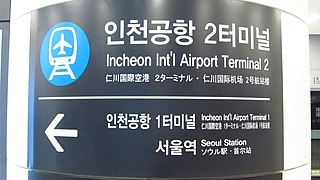
Incheon International Airport Terminal 2 station is a railway station on AREX.

Unseo-dong is neighbourhood of Jung District, Incheon, South Korea. The name Unseo was adopted in 1914 when the administrative district was consolidated.





























